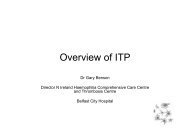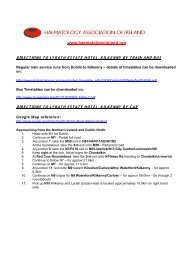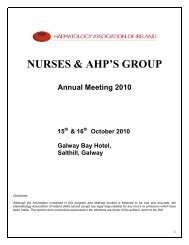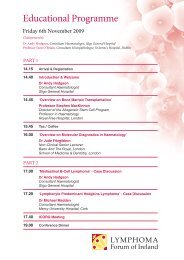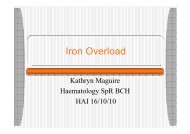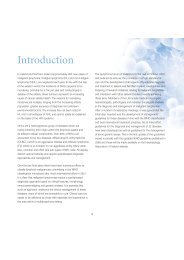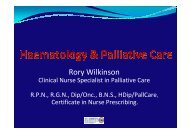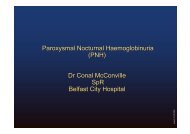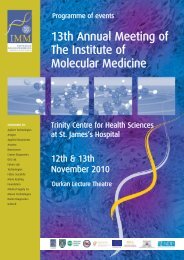Guidelines on Diagnosis and Treatment of Malignant Lymphomas
Guidelines on Diagnosis and Treatment of Malignant Lymphomas
Guidelines on Diagnosis and Treatment of Malignant Lymphomas
Create successful ePaper yourself
Turn your PDF publications into a flip-book with our unique Google optimized e-Paper software.
St<strong>and</strong>ards In <strong>Diagnosis</strong><br />
<strong>of</strong> Lymphoma<br />
Tissue collecti<strong>on</strong><br />
Investigati<strong>on</strong>s prior to biopsy<br />
A full blood count (FBC) <strong>and</strong> film (with flow cytometry if<br />
appropriate), should be carried out before a node biopsy to<br />
avoid biopsying patients with CLL or acute leukaemia.<br />
M<strong>on</strong>ospot: in patients < 30 years with lymphadenopathy.<br />
Epithelial carcinoma should be c<strong>on</strong>sidered in patients >40<br />
with head <strong>and</strong> neck adenopathy, who should have an ENT<br />
examinati<strong>on</strong> <strong>and</strong> FNA.<br />
Designated surge<strong>on</strong>s should perform all lymph<br />
node biopsies in lymphoma diagnosis<br />
A designated surge<strong>on</strong> ensures appropriate <strong>and</strong> uniform<br />
specimen collecti<strong>on</strong> <strong>and</strong> prompt referral <strong>of</strong> patients to the<br />
lymphoma service. The preliminary biopsy report should be<br />
available to the multidisciplinary team (MDT) within 2 weeks <strong>of</strong><br />
the patient’s hospital referral.<br />
An excisi<strong>on</strong> lymph node biopsy is preferable<br />
for diagnosis<br />
An excisi<strong>on</strong> biopsy allows detailed assessment <strong>of</strong> architecture,<br />
which is a key feature in lymphoma diagnosis. Needle biopsies<br />
are more pr<strong>on</strong>e to artefact <strong>and</strong> may be inadequate for all the<br />
diagnostic investigati<strong>on</strong>s. A lymph node biopsy is preferable to a<br />
biopsy <strong>of</strong> an extra-nodal site.<br />
Approach to diagnosis <strong>of</strong> a patient with<br />
lymphadenopathy<br />
■ FBC with film (<strong>and</strong> cell marker studies<br />
where appropriate)<br />
■ M<strong>on</strong>ospot in patients < 30 years<br />
■ C<strong>on</strong>sider ENT examinati<strong>on</strong> <strong>and</strong> FNA to<br />
exclude epithelial malignancy <strong>of</strong> the head <strong>and</strong><br />
neck in patients >40<br />
■ Designated surge<strong>on</strong>(s)<br />
■ Excisi<strong>on</strong> biopsy preferred method; trucut biopsy<br />
if node not accessible<br />
■ Node biopsy – send unfixed to laboratory<br />
Lymph node biopsies should be sent fresh<br />
to the laboratory<br />
This requires local arrangements for the prompt <strong>and</strong> safe<br />
transport <strong>of</strong> the specimen. Fresh material is essential for good<br />
quality histology <strong>and</strong> facilitates the use <strong>of</strong> new diagnostic<br />
techniques. See Royal College <strong>of</strong> Pathologists minimum dataset<br />
for lymphoma reports.<br />
Laboratory diagnosis<br />
Sample h<strong>and</strong>ling<br />
In the laboratory, the lymph node should be sliced <strong>and</strong> imprint<br />
preparati<strong>on</strong>s made. Thin slices should be placed in formalin for<br />
24 hours before processing as paraffin blocks. This is essential<br />
for high-quality morphology <strong>and</strong> reproducible results with marker<br />
studies performed <strong>on</strong> paraffin secti<strong>on</strong>s. The remaining tissue may<br />
be snap frozen <strong>and</strong> disaggregated into a single-cell suspensi<strong>on</strong>.<br />
2



